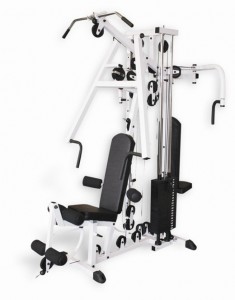 Football is known as “the beautiful game” since it relies on the players endurance, agility, speed, strength and finesse. Besides laying focus on strong legs, football players need strong back, shoulders, neck, arms and chest to win the fight against other players as they avoid injury. A good workout regimen is essential for developing a footballer’s skills and muscle strength. However, not all football players exercise in the same manner.
Football is known as “the beautiful game” since it relies on the players endurance, agility, speed, strength and finesse. Besides laying focus on strong legs, football players need strong back, shoulders, neck, arms and chest to win the fight against other players as they avoid injury. A good workout regimen is essential for developing a footballer’s skills and muscle strength. However, not all football players exercise in the same manner.
Depending on the player’s position, exercises do vary. Major football exercises worked on in the gym include leg, chest, shoulder, triceps and biceps. These exercises target muscles around the chest, neck, shoulders, back, forearms and legs. They guide players on how to improve stamina as well as on how to improve acceleration.
Goalkeeper
Goalkeeping is among the major positions of football. They need a considerably different training approach than outfield players. A goalkeeper requires both explosive and plyometric strength that can be built up with gym equipment. Exercises such as legs, shoulder, biceps, and triceps are also used to guide the player on how to improve strength of the muscles. Since a goalkeeper uses any part of their body to block attempted shots, body parts such as neck, shoulders, forearms, chest and legs should be physically fit. Leg exercises are designed to strengthen muscles located in the lower body for instance buttocks, thighs, calves and hips. These muscles are involved whenever a goalkeeper is picking out attempted long passes and goal kicks, rising up or lifting the ball from the floor.
On the other hand, shoulder exercises are also essential since they strengthen the deltoid muscles situated in the shoulders. These muscles are essential whenever a goalkeeper is raising, throwing the ball or pushing someone away from him. Bicep exercises will also make the muscles positioned in front of a goalkeeper’s upper arms stronger. They are vital for goalkeepers whenever they rotate the forearms, for example, when they are throwing or saving the ball during a football match. Triceps exercises are also done by goalkeepers to toughen the muscles situated at the back of the upper arms. These workouts will help a goalkeeper to catch the ball firmly without any injuries or ailments.
Central defender
These individuals play a huge role in preventing the opposite team from passing the defence and scoring a goal. Apart from remaining organized and balanced, a central defender should also be in a good position to prevent holes in the defence from appearing. During training in the gym, a central defender should mainly focus on exercises targeting the legs, neck, shoulders and chest. These exercises will guide them on how to improve balance as well as how to improve stamina.
Neck and shoulder exercises are important for a central defender since they use their heads to clear the ball. These two exercises target muscles around the shoulders, deltoid muscles and neck region. On the other hand, leg exercises are vital since a defender needs to tackle opponents and jump quite high when clearing the ball. A central defender must also be fast enough to keep up with the opposing strikers and attackers. In addition, chest exercises are essential during gym training since the chest of a defender should be fit enough for running and defence. These exercises target pectoral muscles situated in the chest area.
[sociallocker]
Full back
Full backs generally play in defending and attacking positions therefore, it is important to have their shoulders fit. They play down the left or right flank in any game. For effectiveness, these players should be in great physical shape. Exercises focusing the legs, chest and shoulders are crucial in a full back’s training program. Since full backs run up and down the pitch throughout the game, leg and chest exercises are therefore essential. The workouts will also be of help when a full back slide tackles their opponent. Generally, these exercises target the muscles around the hips, thighs, back, chest and buttocks. Besides the legs and chest, shoulder exercises are also necessary.
Centre Midfield
The centre midfield is often the leader, captain and inspiration of the football team. They need to have every skill from all the positions on the playing field. Since they are constantly involved in the game, their level of concentration should be higher as compared to fellow players. For a centre midfield player to be competent and confident with both feet, their legs should be physically fit. This is why legs exercises are quite important for midfielders.
In addition, these exercises will help midfielders to dribble balls at speed, take free kicks in higher positions, shoot from anywhere within the pitch, tackle opponents and execute a whole range of passes, from “one two’s” to 40-yard diagonal balls. Mostly, leg exercises target muscles within the buttocks, thighs, hips and back. On the other hand, shoulder and neck exercises are also useful since midfielders challenge headers to regain possession of the ball or to head on goal. Biceps and triceps exercises are also imperative when attacking the opponent. Since there is a lot of push and pull, the arms of a midfielder should be fit.
Winger
The winger is a dying breed who is quite dangerous when used effectively. People love to watch them play since they put butts on seats in stadiums with their trickery and flair. Football wingers must have a decent amount of pace as well as be good at running in space with the ball. In addition, they should be able to dribble the ball past players with a lot of ease. However, this can only be achieved by practicing leg exercises. These exercises will guide them on how to improve speed. Leg exercises focus mainly on muscles located within the thighs, hips, back and buttocks. Besides the legs, chest exercises are also imperative during training. These exercises target pectoral muscles within the chest area, they assist wingers to run effectively.
Striker
A striker is a player who plays in the most advanced position on a football pitch out of the team. Their job is to score goals, hold up the ball and act as an outlet/target for their team. Strikers can take part in a two-striker formation, lone striker formation and sometimes a three-striker formation. This is where both football players/strikers go anywhere on the pitch to create space and chances of goal scoring opportunities. This position needs a lot of running since the strikers need to work together to pull away the central defenders which therefore creates space for potentially scoring goals. Strikers should also be physically fit with both feet since they use different playing techniques as they dribble past players.
Therefore, leg exercises are essential during training to guide the players on how to improve stamina as well as on how to improve speed. These exercises mainly target muscles within the hips, buttocks, thighs and back. Chest exercises are also useful during training since players do a lot of running. The pectoral muscles in the chest area should be fit for running long distances within the playing field. Shoulder and neck workouts are also helpful since strikers use their head to challenge in the air for goal kicks, throw ins, free kicks, corners and crosses. They will also use these parts when dribbling the ball. [/sociallocker]


